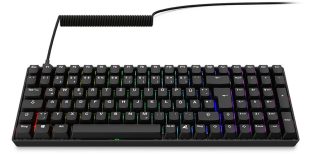We are here to give you a little help when asking the question; why buy a gaming keyboard? We sling terms around like N-key rollover, polling rate, mechanical and membrane… but what do these terms mean for real-world gaming and to the general consumer? Many of our readers may already be up to speed with this terminology, but if you're new to the scene, then this is the guide for you!
What we will cover in this guide:
- Keycaps: the difference between ABS, PBT and double-shot.
- Switches: the difference between mechanical, optical and membrane.
- Switch type: we explain the differences between linear, tactile and clicky along with Cherry MX colour types.
- What is debounce delay?
- What is rollover, N-key rollover (NKRO), X-key rollover?
- What is polling rate and what does it do?
- What does TKL mean and what’s the benefit for gamers?
Here’s a quick explanation of some terms, for more detail make sure to watch our full video!
- ABS keycaps: commonly found moulded caps that can wear easily over time.
- PBT keycaps: often found with higher end keyboards, much more durable and resistant to chemicals, sun, heat and general ware.
- Double shot: instead of printed or lasered, these are made from two layers and are less likely to chip or fade over time.
- Mechanical switches: these work by physical moving parts that create a contact.
- Linear mechanical switches: keystrokes are consistent and smooth with fast actuation.
- Tactile mechanical switches: have a noticeable “bump” near the actuation point.
- Clicky mechanical switches: similar to tactile with the “bump” but make a loud audible click when pressed.
- Optical switches: these use lasers/light beams instead of physical inputs, often much more reliable with faster actuation.
- Membrane switches: a rubber-like membrane makes contact with the circuit board underneath the keys to create the contact.
- Debounce delay: mechanical switches do not make a single on/off contact, instead they create a series of small contacts, switch bounce, when pressed that need filtering out to define the users intended input. Lower debounce delay = better.
- Rollover: the number of keys that can be pressed simultaneously and still be registered.
- Polling rate: the rate that the computer checks for data, 1000Hz polling rate is checked by the PC 1000 times a second. Higher polling rate = better.
- TKL: TKL stands for Ten Key Less, these keyboard’s have no number pad, ideal for small desk environments but also preferred by esports professionals as there is more room for larger mouse movements.
It's also important to keep your keyboard clean, and Overclockers UK has a range dedicated to doing just that. Check it out HERE!
KitGuru says: Gaming keyboards are certainly worthwhile purchases, we hope this guide has helped newcomers to understand that, and can certainly pave the way for higher scores and even more fun! Have you learnt anything new today? Or have we missed something from our guide? Let us know down in the comments.
 KitGuru KitGuru.net – Tech News | Hardware News | Hardware Reviews | IOS | Mobile | Gaming | Graphics Cards
KitGuru KitGuru.net – Tech News | Hardware News | Hardware Reviews | IOS | Mobile | Gaming | Graphics Cards


